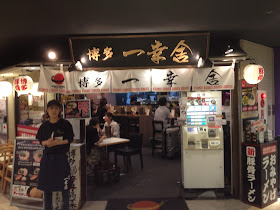It is the time of the year for the annual mega-event in Tokyo -
The second bowl - Special Sapporo Miso Ramen. This is a collaboration by 3 of the top miso ramen stalls in Hokkaido - Menya Saimi, Ramen Iri and Menya Tsukushi. The soup is jointly blended by the 3 owners. It was rich and creamy! The queue for this stall was one of the longest among the 20 stores.
Last but not least - Combination Tonkotsu Ramen. This is a collaboration between 2 ramen brands that have ventured overseas - Keisuke Tonkotsu King in Singapore and Nagi in Hong Kong. The soup is a blend of the tonkotsu soup from both stores. I think it means something when the organizer chose to feature a brand that expanded to Singapore! However, the queue of this store wasn't that long.
The Tokyo Ramen Show!!
As a ramen fan, how can I miss it?
 |
| Patiently queuing up... |
This year in 2012, the Tokyo Ramen Show is held over 2 stretches of days - 26-30 Oct and 31 Oct - 4 Nov 2012. Over each period, there are 20 selected ramen stalls gathered from all over Japan serving their best ramen to fans coming from Tokyo and beyond. Some of the stall are special collaboration stalls setup by famous ramen brands, offering ramen that are only available during limited period of the show. By coming to the Tokyo Ramen Show, not only you can try ramen from different parts of Japan, but also menus that are not available usually.
The show was very well-organised. When you arrive at the venue, you first line up to buy your ramen ticket (800 yen each). With that, you can subsequently to exchange for a bowl of ramen. All the stall are lined up horizontally in one row, and a queue extends from each stall, with fans patiently queuing up. The bowl is slightly smaller than a normal bowl, so that you can try more varieties. There are ample seats that you can take your ramen to too after you've collected your bowl.
For the popular stalls, the queue could be at long at more than an hour. However, there are also shorter queues that you can get your ramen in less than 10 minutes.
There are too many choices to choose from! Assessing that I can eat at most 3 bowls, I picked 3 types of ramen of different taste (and different lengths of queues) to try for this visit.
The first bowl - White Soy Sauce (白醤油) Ramen, a collaboration by 3 different stalls, Shinka, Bigiya and Nawate, all disciples of a famous ramen brand "Setagaya". The soup of this shoyu ramen is excellent - simple but deep with chicken and seafood flavor. The queue for this store was not too long, about 15 minutes.
The second bowl - Special Sapporo Miso Ramen. This is a collaboration by 3 of the top miso ramen stalls in Hokkaido - Menya Saimi, Ramen Iri and Menya Tsukushi. The soup is jointly blended by the 3 owners. It was rich and creamy! The queue for this stall was one of the longest among the 20 stores.
Last but not least - Combination Tonkotsu Ramen. This is a collaboration between 2 ramen brands that have ventured overseas - Keisuke Tonkotsu King in Singapore and Nagi in Hong Kong. The soup is a blend of the tonkotsu soup from both stores. I think it means something when the organizer chose to feature a brand that expanded to Singapore! However, the queue of this store wasn't that long.
Had an excellent spread of something simple, strong and creamy. Personally I like the White Soy Sauce Ramen best, as the soup was the most delicious among the three.
Shall I visit the show this coming weekend too?
I'm extremely tempted to do so!























